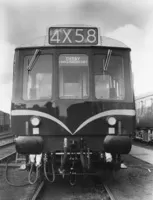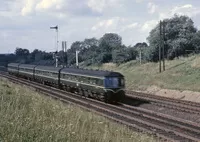Unidentified Class 127 DMU images
Page 1 of 6, displaying 1-20 of 114 images › »

spring 1959
A Derby Works image (negative 59-366) showing the front end of a Class 127 in (circa spring) 1959. The rear of the print was marked "NOT to be issued". This could be to record the first build with the four-character headcode - the Class 125 on the right which were still in production had the two-character. There was also a change from DMU Green on the 125 to the darker Loco Green on the 127. There is one other important detail on this image - the vehicle is unlined. Derby had not lined any of its suburban vehicles at this point - could the original intention have been for the 127s to be delivered without lining? Then a change of plan meant this print wasn't to be used? British Railways.

Unknown Date
The vehicle is identified as a BSO (Brake Second Open) from a QUAD set. It was new 6-10-59. That date, the weight of 40 tons, and the wings on the seat headrests show this is what will later be known as a Class 127. Note the lining ended in a semi-circle rather than being squared off at the corners. Taken possibly at Ampthill before closure circa 1959 by Jim Lawrence. Ian McDonald Collection.

Unknown Date
A London Midland Region publicity image (negative D5547) showing a Derby suburban quad set with a Bedford service in Elstree station, date unknown. British Railways.

circa early 1960s
Two Derby-built four-car suburban DMUs (later known as Class 127s) at Mill Hill Broadway on a St Pancras - Bedford service circa early 1960s. Waddo Rail Archive.

4th August 1962
A 4-car DMU on the Up fast line near Elstree - going a bit too fast for my simple camera! 04/08/1962. John Cosford.

Unknown Date
A four-car Derby suburban Bed-Pan unit (Class 127) at St. Albans City, date unknown. The centre cars are blue, so this was the late sixties. Graham Clark.

Unknown Date
A Bed-Pan unit at St Albans City, circa late 1960s. Graham Clark.

20th June 1965
The 7.20pm St. Pancras - Bedford (Midland Road) service is seen north of Harlington on June, 20th 1965. It is operated by a four-car Derby-built DMU with Rolls-Royce 238hp engines and hydraulic transmission, which would later be known as a Class 127. The coupling code for the type was still blue square at this point. Michael Mensing.

1966
An official image (Derby Works Collection, negative 66/205) from 1966. I'm guessing this is a Class 127 at Cricklewood, cause of damage unknown. British Railways.

February 1966
During investigation of excessive wear in the torque convertors of the Class 127 units, M51622 was fitted with test equipment which caused the cardan shaft to break up near Napsbury on 9 February 1966. This is the recovered parts of the slip ring on no.2 cardan shaft. The London Midland Region image (negative DL3836) was probably taken at Cricklewood depot. British Railways.

February 1966
During investigation of excessive wear in the torque convertors of the Class 127 units, M51622 was fitted with test equipment which caused the cardan shaft to break up near Napsbury on 9 February 1966. This is the recovered parts of the slip ring on no.2 cardan shaft. The London Midland Region image (negative DL3837) was probably taken at Cricklewood depot. British Railways.

February 1966
Underframe equipment under either M51622 or M51632 after the fire at Napsbury on 9 February 1966. It shows a Smiths heater with an engine behind and a radiator to the right. Damage includes disintegrated heater intake ducting and scorching to the cable between the heater and the vehicle and to the insulation on the closest end of the heater. Taken at Cricklewood depot, London Midland Region negative DL3846. British Railways.

February 1966
During investigation of excessive wear in the torque convertors of the Class 127 units, M51622 was fitted with test equipment which caused the cardan shaft to break up, rupture the fuel tank and catch fire near Napsbury on 9 February 1966. These are the cardan shaft pieces afterwards. The caption on the image (Derby Works negative 66/176) reading "No.2 cardan shaft from railcar M51622 superimposed on full size sketch of surrounding equipment". British Railways.

February 1966
During investigation of excessive wear in the torque convertors of the Class 127 units, M51622 was fitted with test equipment which caused the cardan shaft to break up, rupture the fuel tank and catch fire near Napsbury on 9 February 1966. These are the cardan shaft pieces that were recovered. The caption on the image (Derby Works negative 66/177) reading "Portions of fractured cardan shaft (No.2) from railcar M.51622". British Railways.

February 1966
During investigation of excessive wear in the torque convertors of the Class 127 units, M51622 was fitted with test equipment which caused the cardan shaft to break up, rupture the fuel tank and catch fire near Napsbury on 9 February 1966. Images were taken of the recovered components. The caption on this one (Derby Works negative 66/178) reads "Portion of fractured cardan shaft (No.2), bearing slip-ring assembly, from railcar M.51622". British Railways.

February 1966
During investigation of excessive wear in the torque convertors of the Class 127 units, M51622 was fitted with test equipment which caused the cardan shaft to break up, rupture the fuel tank and catch fire near Napsbury on 9 February 1966. Images were taken of the recovered components. The caption on this one (Derby Works negative 66/179) reads "Portion of fractured cardan shaft (No.2), final drive end, from railcar M.51622". British Railways.

February 1966
During investigation of excessive wear in the torque convertors of the Class 127 units, M51622 was fitted with test equipment which caused the cardan shaft to break up, rupture the fuel tank and catch fire near Napsbury on 9 February 1966. Images were taken of the recovered components. The caption on this one (Derby Works negative 66/180) reads "Centre portion of cardan shaft tube and slip-ring carrying portion, showing fractured faces; from No.2 position, railcar M.51622". British Railways.

February 1966
During investigation of excessive wear in the torque convertors of the Class 127 units, M51622 was fitted with test equipment which caused the cardan shaft to break up, rupture the fuel tank and catch fire near Napsbury on 9 February 1966. Images were taken of the recovered components. The caption on this one (Derby Works negative 66/181) reads "Centre portion of cardan shaft tube from No.2 position, railcar M.51622" British Railways.

February 1966
During investigation of excessive wear in the torque convertors of the Class 127 units, M51622 was fitted with test equipment which caused the cardan shaft to break up, rupture the fuel tank and catch fire near Napsbury on 9 February 1966. Images were taken of the recovered components. The caption on this one (Derby Works negative 66/182) reads "Slip ring assembly details from No.2 cardan shaft, railcar M.51622" British Railways.

16th April 1966
The staff of Gretton station, and the crew of the 5.55pm to Bedford, on the last day of services, 16th April 1966. Stuart Mackay Collection.


